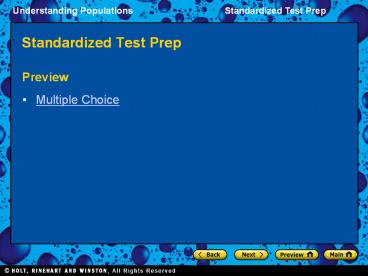Standardized Test Prep - PowerPoint PPT Presentation
1 / 17
Title:
Standardized Test Prep
Description:
Standardized Test Prep Preview Multiple Choice Multiple Choice 1. What determines the carrying capacity of an environment? A. growth rates B. limiting resources C ... – PowerPoint PPT presentation
Number of Views:95
Avg rating:3.0/5.0
Title: Standardized Test Prep
1
Standardized Test Prep
- Preview
- Multiple Choice
2
Multiple Choice
- 1. What determines the carrying capacity of an
environment? - A. growth rates
- B. limiting resources
- C. natural selection
- D. territorial size
3
Multiple Choice
- 1. What determines the carrying capacity of an
environment? - A. growth rates
- B. limiting resources
- C. natural selection
- D. territorial size
4
Multiple Choice, continued
- Which of the following statements can be made
about competition between organisms in a
particular ecosystem? - F. Organisms rarely compete with members of
their own species. - G. Organisms compete directly when they require
the same resources. - H. Organisms only compete when supplies of a
resource are unlimited. - I. Organisms only compete for resources when
their populations are small.
5
Multiple Choice, continued
- Which of the following statements can be made
about competition between organisms in a
particular ecosystem? - F. Organisms rarely compete with members of
their own species. - G. Organisms compete directly when they require
the same resources. - H. Organisms only compete when supplies of a
resource are unlimited. - I. Organisms only compete for resources when
their populations are small.
6
Multiple Choice, continued
- 3. Which of the following describes a species
niche? - A. the unique role the species plays in an
ecosystem - B. the physical location where the species can
be found on Earth - C. the adaptation of a species population to its
physical environment - D. the maximum number of offspring all members
of that species can produce
7
Multiple Choice, continued
- 3. Which of the following describes a species
niche? - A. the unique role the species plays in an
ecosystem - B. the physical location where the species can
be found on Earth - C. the adaptation of a species population to its
physical environment - D. the maximum number of offspring all members
of that species can produce
8
Multiple Choice, continued
- 4. Which of the following expressions is used to
calculate the change in population size? - F. births plus deaths
- G. births plus deaths plus population
- H. births minus deaths
- I. births minus deaths plus population
9
Multiple Choice, continued
- 4. Which of the following expressions is used to
calculate the change in population size? - F. births plus deaths
- G. births plus deaths plus population
- H. births minus deaths
- I. births minus deaths plus population
10
Multiple Choice, continued
- Use this table to answer question 5.
11
Multiple Choice, continued
- 5. Which of the interactions listed in the table
is harmful to both species? - A. commensalism
- B. competition
- C. mutualism
- D. predation
12
Multiple Choice, continued
- 5. Which of the interactions listed in the table
is harmful to both species? - A. commensalism
- B. competition
- C. mutualism
- D. predation
13
Multiple Choice, continued
- Use this illustration to answer questions 6 and 7.
14
Multiple Choice, continued
- 6. What happens to population size between the
time it overshoots carrying capacity to when it
recovers and stabilizes? - F. It remains stable.
- G. It declines steadily.
- H. It decreases before it stabilizes.
- I. It continues to increase at a steady rate.
15
Multiple Choice, continued
- 6. What happens to population size between the
time it overshoots carrying capacity to when it
recovers and stabilizes? - F. It remains stable.
- G. It declines steadily.
- H. It decreases before it stabilizes.
- I. It continues to increase at a steady rate.
16
Multiple Choice, continued
- 7. If the population size was nearly 2,000 when
it overshot carrying capacity, and 1,500 when it
was at its lowest amount of decline during its
recovery, what is the estimated carrying capacity
of the population? - A. 1,600
- B. 1,750
- C. 1,800
- D. 1,950
17
Multiple Choice, continued
- 7. If the population size was nearly 2,000 when
it overshot carrying capacity, and 1,500 when it
was at its lowest amount of decline during its
recovery, what is the estimated carrying capacity
of the population? - A. 1,600
- B. 1,750
- C. 1,800
- D. 1,950




















![[PDF] TEXAS STAAR Test Prep: 4th Grade Math Practice Workbook and Full-length Online Assessments: STAAR Study Guide (STAAR Redesign by Lumos Learning) Ipad PowerPoint PPT Presentation](https://s3.amazonaws.com/images.powershow.com/10102430.th0.jpg?_=20240820073)





![[PDF]❤READ⚡ US Citizenship Test Study Guide 2021 and 2022: USCIS Naturalization Secrets for Bot PowerPoint PPT Presentation](https://s3.amazonaws.com/images.powershow.com/10062620.th0.jpg?_=20240624052)

![PDF Download US Citizenship Test Study Guide 2021 and 2022: USCIS Naturalization Secrets for Both Exam Versions, Complete Practice Question List, Detailed Answer Explanations: [2nd Edition] PowerPoint PPT Presentation](https://s3.amazonaws.com/images.powershow.com/10063285.th0.jpg?_=202406240811)


